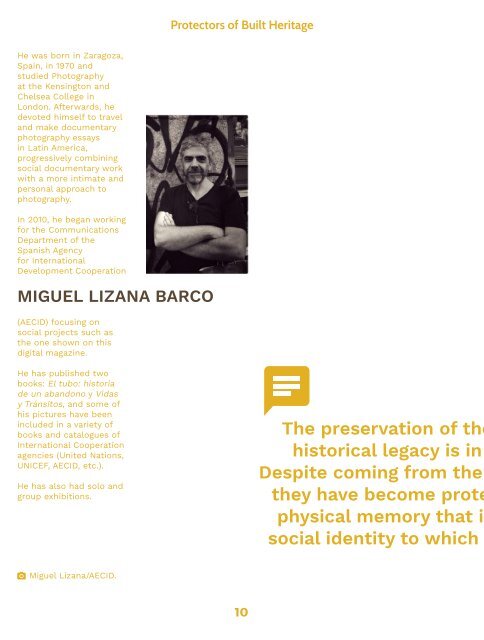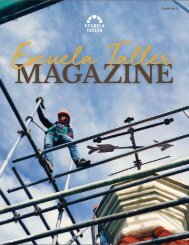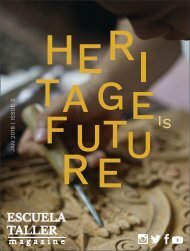Escuela Taller Magazine - Issue 1
Escuela Taller Magazine is the official magazine of Escuela Taller de Filipinas Foundation Inc. (ETFFI). Escuela Taller is a training center situated in Intramuros, the historical walled city of Manila, whose main objective is to equip the youth with knowledge and specialized skills to help them uplift their economic status while focusing on the preservation of heritage structures. Our trainees are the protectors of the Philippine built heritage.
Escuela Taller Magazine is the official magazine of Escuela Taller de Filipinas Foundation Inc. (ETFFI).
Escuela Taller is a training center situated in Intramuros, the historical walled city of Manila, whose main objective is to equip the youth with knowledge and specialized skills to help them uplift their economic status while focusing on the preservation of heritage structures. Our trainees are the protectors of the Philippine built heritage.
Create successful ePaper yourself
Turn your PDF publications into a flip-book with our unique Google optimized e-Paper software.
Protectors of Built Heritage<br />
Protectors of Built Heritage<br />
He was born in Zaragoza,<br />
Spain, in 1970 and<br />
studied Photography<br />
at the Kensington and<br />
Chelsea College in<br />
London. Afterwards, he<br />
devoted himself to travel<br />
and make documentary<br />
photography essays<br />
in Latin America,<br />
progressively combining<br />
social documentary work<br />
with a more intimate and<br />
personal approach to<br />
photography.<br />
In 2010, he began working<br />
for the Communications<br />
Department of the<br />
Spanish Agency<br />
for International<br />
Development Cooperation<br />
MIGUEL LIZANA BARCO<br />
(AECID) focusing on<br />
social projects such as<br />
the one shown on this<br />
digital magazine.<br />
He has published two<br />
books: El tubo: historia<br />
de un abandono y Vidas<br />
y Tránsitos, and some of<br />
his pictures have been<br />
included in a variety of<br />
books and catalogues of<br />
International Cooperation<br />
agencies (United Nations,<br />
UNICEF, AECID, etc.).<br />
He has also had solo and<br />
group exhibitions.<br />
Miguel Lizana/AECID.<br />
In the 1980s, one of the most<br />
significant migration flows from<br />
the provinces to the city in the<br />
country’s recent history took<br />
place. Thousands of people<br />
moved from the entire Philippine<br />
countryside to the capital in<br />
search of opportunities --those<br />
which could not be found in the<br />
country’s rural areas which were<br />
still waiting for agrarian reform, and<br />
were characterized by the lack of<br />
infrastructure, basic services and<br />
jobs. A lot of these migrants ended<br />
up in BASECO, building their houses<br />
along the muddy banks of the Pasig<br />
River, where the hustle and bustle<br />
of the port could offer them a few<br />
pesos working as porters or doing<br />
some other job.<br />
People from other marginalized<br />
areas of the metropolis also<br />
arrived at BASECO, having had their<br />
shanties demolished or destroyed<br />
in a fire. There were also Filipino<br />
Muslims and Christians fleeing<br />
from the conflict in Mindanao,<br />
relatives from Pampanga, Batanes<br />
or Zamboanga following the suit<br />
of their family members who<br />
first settled there. They all came<br />
with the usual problems which<br />
accompany poverty in areas such<br />
The preservation of their country’s<br />
historical legacy is in their hands.<br />
Despite coming from the peripheries,<br />
they have become protectors of the<br />
physical memory that is part of the<br />
social identity to which they belong.<br />
as this one -- forgotten, brutally<br />
lacking in structure, and the seed<br />
of the underclass: delinquency,<br />
weapons, crime, drugs, organ<br />
trafficking.<br />
It was here where a lot of the<br />
students of the <strong>Escuela</strong> <strong>Taller</strong> de<br />
Filipinas Foundation, Inc. (ETTFI)<br />
were born. Some of the stories of<br />
of these men and women – those<br />
of the latter being twice as hard -<br />
are examples of each one of the<br />
chapters of the consequences of<br />
marginalization: abandonment,<br />
mistreatment, addiction, rape, and<br />
exploitation. Nevertheless, these<br />
stories also serve as an example of<br />
improvement, of the desire to move<br />
forward and seek a better future.<br />
Having the opportunity to study<br />
and acquire some technical<br />
skills – in this case, those related<br />
to traditional techniques of<br />
construction and methods of<br />
restoration – allow these young<br />
men and women to have a greater<br />
access to the labor market and to<br />
attain better living conditions for<br />
themselves and their families. This<br />
also leads to social participation,<br />
interaction in the public sphere,<br />
and recognition as skilled persons<br />
with the power to decide and<br />
exert a positive influence on their<br />
surroundings.<br />
Given this description, the <strong>Escuela</strong><br />
<strong>Taller</strong> de Filipinas would be just<br />
another training center for young<br />
men and women at risk of social<br />
exclusion. However, that is not the<br />
case. The students of the <strong>Escuela</strong><br />
<strong>Taller</strong> have as their classrooms the<br />
adobe walls of a historical church<br />
in Santa Ana, the choir seats made<br />
of narra in the San Agustin Church,<br />
a structure that is considered<br />
a World Heritage site by the<br />
UNESCO, or the most emblematic<br />
fortification of Intramuros – Fort<br />
Santiago. That was how it began<br />
in Spain and is being continued in<br />
other <strong>Escuela</strong> <strong>Taller</strong> centers in Latin<br />
America.<br />
The preservation of their country’s<br />
historical legacy is in their<br />
hands. Despite coming from the<br />
peripheries, they have become<br />
protectors of the physical memory<br />
that is part of the social identity to<br />
which they belong. This symbolism<br />
is a fundamental pillar in the<br />
empowerment of these girls and<br />
boys who wake up between the<br />
tarpaulins of a house without<br />
running water, and who end<br />
their days painting the ceiling of<br />
the house of the heroes of the<br />
1896 revolution. As participants,<br />
they become visible and redeem<br />
themselves.<br />
These are the trainees of the<br />
<strong>Escuela</strong> <strong>Taller</strong> de Filipinas,<br />
the protectors of the tangible<br />
Philippine legacy.<br />
10 11





